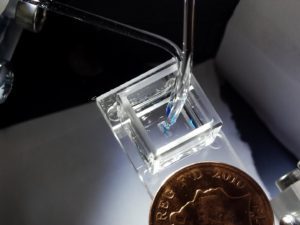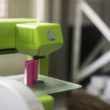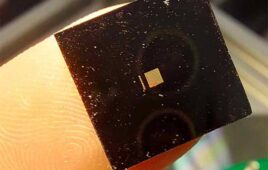
This is an image of the 3-D droplet bioprinter, developed by the Bayley Research Group at Oxford, producing mm-sized tissues. [Image from Sam Olof/Alexander Graham]
Researchers at the University of Oxford and the Center for Molecular Medicine at Bristol were able to showcase how human and animal cells could be printed into high-resolution tissue constructs.
Being able to control the position of cells in a 3D structure has been a challenge to researchers in the past. The cells are known to move around with in the structure and the soft scaffolding which can result in the scaffolding collapsing on itself.
The Oxford researchers contained cells in a protective layer of nanoliter droplets that were wrapped in a lipid coating. The coating could be assembled layer-by-layer into living structures. If tissues are printed using this method, the researchers say that the survival rate of individual cells improves. Then they can build each tissue using one drop at a time to a resolution that works best.
In order for this method to work, the artificial tissues have to be able to replicate the behavior and functions of the human body. Doing so allows for patterned cellular constructs to be made which by the time it’s fully grown, it will act like or enhance natural tissues in the body.
“We were aiming to fabricate three-dimensional living tissues that could display the basic behaviors and physiology found in natural organisms. To date, there are limited examples of printed tissues, which have the complex cellular architecture of native tissues,” Alexander Grahm, lead author and 3D bioprinting scientist at Oxford Synthetic Biology, said in a press release. “Hence, we focused on designing a high-resolution cell printing platform, from relatively inexpensive components, that could be used to reproducibly produce artificial tissues with appropriate complexity from a range of cells including stem cells.”
The researchers are working on commercializing the technique for industrial and biomedical purposes. They are also working to create new complementary printing methods that could include a variety of living and hybrid materials for industrial scale tissue production.
“The bioprinting approach developed with Oxford University is very exciting, as the cellular constructs can be printed efficiently at extremely high resolution with very little waste,” said Adam Perriman, who is a member of the University of Bristol’s school of cellular and molecular medicine. “The ability to 3D print with adult stem cells and still have them differentiate was remarkable, and really shows the potential of this new methodology to impact regenerative medicine globally.”
The researchers hope that their work will be further developed so that the materials could have a bigger impact on healthcare around the world. They suggest that it could shape reproducible human tissue models that could eliminate the need for animal testing.
“There are many potential applications for bioprinting, and we believe it will be possible to create personalized treatments by using cells sourced from patients to mimic or enhance natural tissue function,” said Sam Olof, chief technology officer at Oxford Synthetic Biology. “In the future, 3D bio-printed tissues may be also be used for diagnostic applications – for example, for drug or toxin screening.”
(See the best minds in medtech live at DeviceTalks Boston on Oct. 2.)






